Lecco's lake villas
Villa Manzoni
T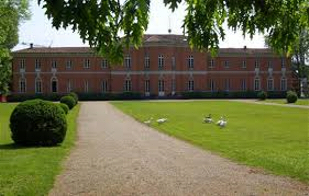 he Villa of Manzoni at Caleotto has always been a source of great appeal: the fact that the poet spent part of his youth there and that the plot of The Betrothed originated here explains the interest of a wide circle of enthusiasts. The rooms where the family lived are on the ground level of the Villa, as are the outhouses of the stables. The neoclassical Chapel of the Assumption is within the property boundary, and houses the remains of the poet's father. The Villa also accommodates the Pinacoteca Comunale (Municipal Art Gallery), with many paintings from the 17th and 18th century Lombard school; noteworthy, too, is the main reception room containing classical decorations.
he Villa of Manzoni at Caleotto has always been a source of great appeal: the fact that the poet spent part of his youth there and that the plot of The Betrothed originated here explains the interest of a wide circle of enthusiasts. The rooms where the family lived are on the ground level of the Villa, as are the outhouses of the stables. The neoclassical Chapel of the Assumption is within the property boundary, and houses the remains of the poet's father. The Villa also accommodates the Pinacoteca Comunale (Municipal Art Gallery), with many paintings from the 17th and 18th century Lombard school; noteworthy, too, is the main reception room containing classical decorations.
Villa Carlotta
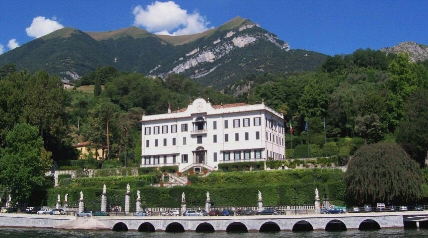 Although it is less prestigious than Villa d'Este and lacks in fascination compared to the legendary villa Pliniana, Villa Carlotta still stands out as one of the most visited among the great villas of the Lario, a mass-tourism destination, principally in spring time. The spacious park rich with exotic plants, and the villa interior with halls and salons decorated with furniture of the epoch, magnificent tapestries, statues by Canova and an original painting by Hayez, render this villa an authentic piece of art. It was Lawyer Gian Battista Sommariva who brought these art treasures together. Sommariva, art enthusiast and amateur agronome, acquired the palace in 1801 and transformed large areas of the gardens by adopting the new canons of the English-style garden. Following his death, the villa was sold for 780.000 lire to the queen of Prussia, Marianna of Nassau, which, in turn, donated it her daughter on occasion of her marriage to Duke Georg II von Sachsen-Meiningen. Carlotta died in 1855 at only 23 years of age, but the Meiningen family, who had converted the villa into a summer residence, restyling the garden according to the late-Romantic canons of the time, kept the property until the outburst of World War I. The great C featured on the entrance gate does not stand for Carlotta but refers to the first owner, marquis of Milan Giorgio Clerici, who had erected the villa in 1690. As of today, Villa Carlotta is property of the Italian government.
Although it is less prestigious than Villa d'Este and lacks in fascination compared to the legendary villa Pliniana, Villa Carlotta still stands out as one of the most visited among the great villas of the Lario, a mass-tourism destination, principally in spring time. The spacious park rich with exotic plants, and the villa interior with halls and salons decorated with furniture of the epoch, magnificent tapestries, statues by Canova and an original painting by Hayez, render this villa an authentic piece of art. It was Lawyer Gian Battista Sommariva who brought these art treasures together. Sommariva, art enthusiast and amateur agronome, acquired the palace in 1801 and transformed large areas of the gardens by adopting the new canons of the English-style garden. Following his death, the villa was sold for 780.000 lire to the queen of Prussia, Marianna of Nassau, which, in turn, donated it her daughter on occasion of her marriage to Duke Georg II von Sachsen-Meiningen. Carlotta died in 1855 at only 23 years of age, but the Meiningen family, who had converted the villa into a summer residence, restyling the garden according to the late-Romantic canons of the time, kept the property until the outburst of World War I. The great C featured on the entrance gate does not stand for Carlotta but refers to the first owner, marquis of Milan Giorgio Clerici, who had erected the villa in 1690. As of today, Villa Carlotta is property of the Italian government.
Villa Monastero
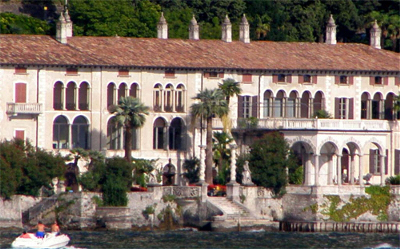 Once upon a time, about eight hundred years ago, there was a little monastery kept by Cistercian nuns. The building dates back presumably to the time of the wars between the communes and the Holy Roman Empire. The monastery is believed to have been founded by a group of faithful followers who had escaped from the Comacina Island, after the churches there had been destroyed and the inhabitants of Varenna sent into exile. Years later, the nuns were transferred to an abbey of Lecco and archbishop Borromeo sold the building to a noble from Valsassina, Paolo Mornico, who took it over in 1569. Over the years, his heirs made several improvements to the monastery, converting it into a magnificent gentleman’s residence with its 17th century façade and symmetrical porticos, while the garden was predominantly destined to agriculture. The German Walter Kees carried out further reconstruction works until achieving the final design, which is still as we see it today. He also laicized the little church and created the splendid tropical garden (1904). The apparent inconsistency between architectural styles is mitigated by the overall design, which unites artistic and architectural elements drawn from diverse motifs ranging from neoclassical (the tempietto), baroque (the balustrade), eclectical (the porter’s lodge) and exotic (the tortile columns). At the end of World War I, the villa was seized and confiscated as enemy’s property and conceded to the National Institute for War Veterans. Later on it became an institute for hydrology studies (inaugurated by Bottai in 1940). At present the Villa is seat of the C.N.R. (National Council of Research) where high culture conferences are held. Physicist Enrico Fermi held his last lecture in public here in 1955
Once upon a time, about eight hundred years ago, there was a little monastery kept by Cistercian nuns. The building dates back presumably to the time of the wars between the communes and the Holy Roman Empire. The monastery is believed to have been founded by a group of faithful followers who had escaped from the Comacina Island, after the churches there had been destroyed and the inhabitants of Varenna sent into exile. Years later, the nuns were transferred to an abbey of Lecco and archbishop Borromeo sold the building to a noble from Valsassina, Paolo Mornico, who took it over in 1569. Over the years, his heirs made several improvements to the monastery, converting it into a magnificent gentleman’s residence with its 17th century façade and symmetrical porticos, while the garden was predominantly destined to agriculture. The German Walter Kees carried out further reconstruction works until achieving the final design, which is still as we see it today. He also laicized the little church and created the splendid tropical garden (1904). The apparent inconsistency between architectural styles is mitigated by the overall design, which unites artistic and architectural elements drawn from diverse motifs ranging from neoclassical (the tempietto), baroque (the balustrade), eclectical (the porter’s lodge) and exotic (the tortile columns). At the end of World War I, the villa was seized and confiscated as enemy’s property and conceded to the National Institute for War Veterans. Later on it became an institute for hydrology studies (inaugurated by Bottai in 1940). At present the Villa is seat of the C.N.R. (National Council of Research) where high culture conferences are held. Physicist Enrico Fermi held his last lecture in public here in 1955
Villa Melzi
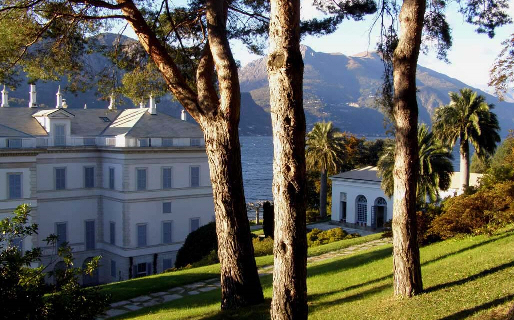 Legacy of an aristocratic epoch and jealous of its noble atmosphere, Villa Melzi has retained until today its role of private abode. Built in 1808 in a characteristic and austere neoclassical style, the villa was property of Francis Melzi of Eryl, gran chancellor of the Kingdom of Italy and close friend of Napoleon. Many illustrious personalities have sojourned at the villa, amongst which Franz Liszt, Stendhal, the Emperors of Austria Francis I and Ferdinand, viceroy Eugenio Beauharnais and tsarina Feodorowna. Strange to say, but Napoleon preferred to holiday at Villa Pliniana instead. The collection of art treasures is mostly influenced by the predilection of the Romantics for exoticism and nostalgia for the past, typical trait of the great villas of the lakes of Lombardia. The villa has a Moorish-style kiosk, a funerary monument with a portal in Renaissance style, the Egyptian sphinxes of the goddess Sekhnet, several Roman relics, an Etruscan urn, a Greek stele, a drawing by Van Dick, a Moor by Rubens and a Venetian gondola that was brought to Bellagio under the orders of Napoleon. Franz Liszt draw inspiration from this garden for his sonata D'après une lecture du Dante, while walking side by side with Maria d'Agoult and delighting in the enchanting and peaceful atmosphere of the lake. Liszt named her daughter Cosima (born on the Lario on Christmas Eve, 1837) out of his great love for the Lake of Como. Cosima would later on marry musician Richard Wagner.
Legacy of an aristocratic epoch and jealous of its noble atmosphere, Villa Melzi has retained until today its role of private abode. Built in 1808 in a characteristic and austere neoclassical style, the villa was property of Francis Melzi of Eryl, gran chancellor of the Kingdom of Italy and close friend of Napoleon. Many illustrious personalities have sojourned at the villa, amongst which Franz Liszt, Stendhal, the Emperors of Austria Francis I and Ferdinand, viceroy Eugenio Beauharnais and tsarina Feodorowna. Strange to say, but Napoleon preferred to holiday at Villa Pliniana instead. The collection of art treasures is mostly influenced by the predilection of the Romantics for exoticism and nostalgia for the past, typical trait of the great villas of the lakes of Lombardia. The villa has a Moorish-style kiosk, a funerary monument with a portal in Renaissance style, the Egyptian sphinxes of the goddess Sekhnet, several Roman relics, an Etruscan urn, a Greek stele, a drawing by Van Dick, a Moor by Rubens and a Venetian gondola that was brought to Bellagio under the orders of Napoleon. Franz Liszt draw inspiration from this garden for his sonata D'après une lecture du Dante, while walking side by side with Maria d'Agoult and delighting in the enchanting and peaceful atmosphere of the lake. Liszt named her daughter Cosima (born on the Lario on Christmas Eve, 1837) out of his great love for the Lake of Como. Cosima would later on marry musician Richard Wagner.
Villa Pliniana
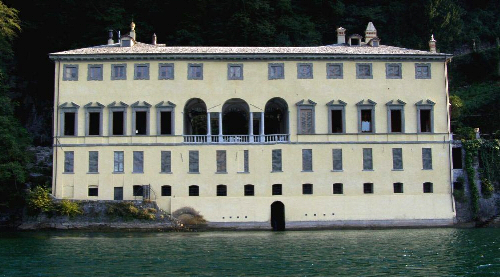 In an unspecified year of the 19th century, Corrado Silla, a young and unknown writer, was guest of earl Cesare d’Ormengo at villa Pliniana. Marina, the proud niece of the earl, occupied the room where a certain Cecilia, wife of an earl descendant from the d’Ormengo family, had died. Cecilia had been held prisoner in the villa by her husband as a punishment for a clandestine liaison. Marina believed herself to be the reincarnation of Cecilia; she could perceive her voce and fierce thirst for revenge. Silla - who was already bound to Cecilia through an exchange of letters concerning one of the writer’s works, “Fantasmi del passato” (Ghosts from the past) - was literally captivated by Marina’s allure, and tried to escape, in vain, from the palace. Marina, in a moment of lucid madness, drowned him together with her uncle and in the end, drowned herself in the same waters of the lake. This is a summary of the story narrated in Malombra, the novel written by Fogazzaro in 1881, inspired to the gloomy atmosphere of villa Pliniana. Film-maker Mario Soldati shot several scenes here for his homonymous film, a true masterpiece of Italian cinema. As a matter of fact, a legend suggests that the villa is still haunted by ghosts who used to torment the first owner, the governor of Como, Giovanni Anguissola, assassinated in 1578. But perhaps the most enthralling period traces back to the times of the Milanese prince Enrico Belgioioso, who had a secret and overwhelming love affair with Anna Berthier, princess of Wagram and consort to the duke of Plaisance. Every night, after the clock struck midnight, the two lovers would wrap themselves in a white sheet and jump down from the balcony overlooking the lake. The love affair lasted eight long years until the day when Anna unexpectedly abandoned her companion and left him all alone in the palace. Enrico, literally grief-stricken, died in Milan in 1858. Villa Pliniana passed to the Belgioioso descendants who resided there for another century before moving to the castle of Masino, in Piedmont. From then on, the villa has been lying abandoned, immersed in the suggestive melancholy of the Larian landscape and now a dwelling place for memories and shadows of past generations of illustrious Italian and foreign visitors: Napoleon, Berchet, Byron, Shelley, Stendhal, Foscolo, Fogazzaro, Rossini, Bellini and Liszt. An intermittent fountain that gushes out from a rock - also mentioned by Pliny and Leonardo da Vinci - is really worthy of note. The fountain is enclosed inside the building. Villa Pliniana, with its history and legendary aura, represents one the most valued treasures of the Lake of Como.
In an unspecified year of the 19th century, Corrado Silla, a young and unknown writer, was guest of earl Cesare d’Ormengo at villa Pliniana. Marina, the proud niece of the earl, occupied the room where a certain Cecilia, wife of an earl descendant from the d’Ormengo family, had died. Cecilia had been held prisoner in the villa by her husband as a punishment for a clandestine liaison. Marina believed herself to be the reincarnation of Cecilia; she could perceive her voce and fierce thirst for revenge. Silla - who was already bound to Cecilia through an exchange of letters concerning one of the writer’s works, “Fantasmi del passato” (Ghosts from the past) - was literally captivated by Marina’s allure, and tried to escape, in vain, from the palace. Marina, in a moment of lucid madness, drowned him together with her uncle and in the end, drowned herself in the same waters of the lake. This is a summary of the story narrated in Malombra, the novel written by Fogazzaro in 1881, inspired to the gloomy atmosphere of villa Pliniana. Film-maker Mario Soldati shot several scenes here for his homonymous film, a true masterpiece of Italian cinema. As a matter of fact, a legend suggests that the villa is still haunted by ghosts who used to torment the first owner, the governor of Como, Giovanni Anguissola, assassinated in 1578. But perhaps the most enthralling period traces back to the times of the Milanese prince Enrico Belgioioso, who had a secret and overwhelming love affair with Anna Berthier, princess of Wagram and consort to the duke of Plaisance. Every night, after the clock struck midnight, the two lovers would wrap themselves in a white sheet and jump down from the balcony overlooking the lake. The love affair lasted eight long years until the day when Anna unexpectedly abandoned her companion and left him all alone in the palace. Enrico, literally grief-stricken, died in Milan in 1858. Villa Pliniana passed to the Belgioioso descendants who resided there for another century before moving to the castle of Masino, in Piedmont. From then on, the villa has been lying abandoned, immersed in the suggestive melancholy of the Larian landscape and now a dwelling place for memories and shadows of past generations of illustrious Italian and foreign visitors: Napoleon, Berchet, Byron, Shelley, Stendhal, Foscolo, Fogazzaro, Rossini, Bellini and Liszt. An intermittent fountain that gushes out from a rock - also mentioned by Pliny and Leonardo da Vinci - is really worthy of note. The fountain is enclosed inside the building. Villa Pliniana, with its history and legendary aura, represents one the most valued treasures of the Lake of Como.Villa d'Este
 Villa d’Este, a majestic luxury hotel, universal emblem of the Lake of Como, is situated along the gulf of Cernobbio. After five centuries and many ups and downs, it stands today as a contemporary symbol, with no obligations towards the past. It is like a window on the world: the celebrated personalities that frequent this place - those from the politic scene and the fashion and show industry alike - know little or nothing about the lake and its history. A holiday at Villa d’Este is an uncommon occurrence in itself. The building was erected in 1557 as a small private villa for cardinal Gallio. The complex has undergone considerable remodelling over the centuries, with many modifications to its external features. Boldoni, in 1616, writes about its extensive gardens, now rendered charming by trees, now by ponds, divided by a long avenue and bordered by mosaics. The park was the venue of the clandestine love affairs of Vittorina Peluso, known as Pelusina, a ballerina with a bad reputation, and consort to Domenico Pino, general of the Napoleonic army. There is also an intriguing creation composed of walls and small faux fortresses which Vittoria had commissioned as a tribute to her husband on his return from Spain, and where she would spend her time dreaming of and envisaging invasions from the lake. Such idle and loose lifestyle came abruptly to an end after the fall of Napoleon. In 1815, the English entered the scene: the villa was acquired by the daughter of George III of England, Caroline of Brunswick, who was utterly fascinated by the beauty of the Larian landscape. She renamed the villa with her real name in virtue of her (alleged) lineage that traced back to the Estense, without making any distinction with the villa of Tivoli. In 1868 the complex passed to the widow of Zar Nicholas I. The villa was eventually acquired in 1873 by a Milanese company who converted it into one of the most famous hotels in the world, which has counted with the presence of many illustrious visitors: the Moroccan Sultan, the Saudi Arabian Royal Family, the king of Holland, the king of Norway, the king of Munich, ministers Ciano and von Ribbentrop, president Kennedy, Orson Welles, Clark Gable, Ricky Martin, Versace, Madonna, Arnold Schwarzenegger, Robert de Niro, Yasser Arafat... just to mention some.The villa is also a venue for important finance conferences; the Ambrosetti Forum is held here every year, while the Bilderberg Group held meetings back in 1965 and 1987.
Villa d’Este, a majestic luxury hotel, universal emblem of the Lake of Como, is situated along the gulf of Cernobbio. After five centuries and many ups and downs, it stands today as a contemporary symbol, with no obligations towards the past. It is like a window on the world: the celebrated personalities that frequent this place - those from the politic scene and the fashion and show industry alike - know little or nothing about the lake and its history. A holiday at Villa d’Este is an uncommon occurrence in itself. The building was erected in 1557 as a small private villa for cardinal Gallio. The complex has undergone considerable remodelling over the centuries, with many modifications to its external features. Boldoni, in 1616, writes about its extensive gardens, now rendered charming by trees, now by ponds, divided by a long avenue and bordered by mosaics. The park was the venue of the clandestine love affairs of Vittorina Peluso, known as Pelusina, a ballerina with a bad reputation, and consort to Domenico Pino, general of the Napoleonic army. There is also an intriguing creation composed of walls and small faux fortresses which Vittoria had commissioned as a tribute to her husband on his return from Spain, and where she would spend her time dreaming of and envisaging invasions from the lake. Such idle and loose lifestyle came abruptly to an end after the fall of Napoleon. In 1815, the English entered the scene: the villa was acquired by the daughter of George III of England, Caroline of Brunswick, who was utterly fascinated by the beauty of the Larian landscape. She renamed the villa with her real name in virtue of her (alleged) lineage that traced back to the Estense, without making any distinction with the villa of Tivoli. In 1868 the complex passed to the widow of Zar Nicholas I. The villa was eventually acquired in 1873 by a Milanese company who converted it into one of the most famous hotels in the world, which has counted with the presence of many illustrious visitors: the Moroccan Sultan, the Saudi Arabian Royal Family, the king of Holland, the king of Norway, the king of Munich, ministers Ciano and von Ribbentrop, president Kennedy, Orson Welles, Clark Gable, Ricky Martin, Versace, Madonna, Arnold Schwarzenegger, Robert de Niro, Yasser Arafat... just to mention some.The villa is also a venue for important finance conferences; the Ambrosetti Forum is held here every year, while the Bilderberg Group held meetings back in 1965 and 1987.
Villa Olmo
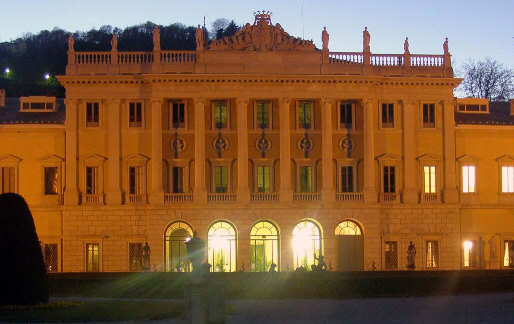 1780. Marquis Innocenzo Odescalchi, greatly influenced by his humanistic studies which he had carried out in Rome, decided to build a great villa in the locality of Borgo Vico, in the surroundings of Como (today entirely incorporated into the fabric of the city). The land was named dell’olmo (of the elm) after a giant century-old elm tree, sole survivor of the three great plane trees exalted by Pliny, according to legend. The project was commissioned to Simone Cantoni and the works lasted about twenty years. The two side wings of the building that noticeably weighed down the structure were not contemplated in the original project but were added later on, in 1797. After the death of Odescalchi, the villa was handed down to the young marquis Raimondi, which, after hosting numerous crowned heads of Europe, such as the emperor of Austria, the prince of Metternich, Radestzky, Maria Christina of Bourbon and the lover of zar Nicholas I, had the idea of giving his support to the popular insurrection of 1848; as a result, he had to flee and seek refuge in Switzerland. It was the beginning of a long period of decadence for the villa, which had also been the setting of the love story between Garibaldi and the owner’s daughter, Giuseppina Raimondi, whom he married in Fino Mornasco in 1860. However, plans for transforming the villa into a luxury hotel had vanished and was eventually purchased for 270.000 lire by the Viscounts of Modrone, a traditional middle-class family that was not acquainted with its past aristocratic magnificence. By this time, even the lake community had changed and in 1925, Villa Olmo was acquired by the Como City Council and converted it into a prestigious venue for exhibitions and meetings, while the magnificent garden is now a public park.
1780. Marquis Innocenzo Odescalchi, greatly influenced by his humanistic studies which he had carried out in Rome, decided to build a great villa in the locality of Borgo Vico, in the surroundings of Como (today entirely incorporated into the fabric of the city). The land was named dell’olmo (of the elm) after a giant century-old elm tree, sole survivor of the three great plane trees exalted by Pliny, according to legend. The project was commissioned to Simone Cantoni and the works lasted about twenty years. The two side wings of the building that noticeably weighed down the structure were not contemplated in the original project but were added later on, in 1797. After the death of Odescalchi, the villa was handed down to the young marquis Raimondi, which, after hosting numerous crowned heads of Europe, such as the emperor of Austria, the prince of Metternich, Radestzky, Maria Christina of Bourbon and the lover of zar Nicholas I, had the idea of giving his support to the popular insurrection of 1848; as a result, he had to flee and seek refuge in Switzerland. It was the beginning of a long period of decadence for the villa, which had also been the setting of the love story between Garibaldi and the owner’s daughter, Giuseppina Raimondi, whom he married in Fino Mornasco in 1860. However, plans for transforming the villa into a luxury hotel had vanished and was eventually purchased for 270.000 lire by the Viscounts of Modrone, a traditional middle-class family that was not acquainted with its past aristocratic magnificence. By this time, even the lake community had changed and in 1925, Villa Olmo was acquired by the Como City Council and converted it into a prestigious venue for exhibitions and meetings, while the magnificent garden is now a public park.
Villa Pizzo
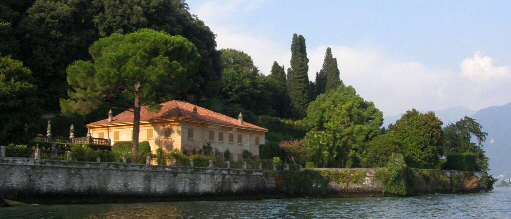 The original nucleus of the villa dates back to 1435 and was property of Giovanni Mugiasca, a rich merchant from Como. It was a simple farmhouse that was fitted out as a lazaretto during the great plague that struck Europe in the 17th century. The building was enlarged in 1700 and handed down to the hospital of S. Anna of Como, which, in turn, ceded it to Archduke Rainer of Augsburg, viceroy of the Lombardo-Venetian kingdom. It was acquired twenty years later by a rich Parisian noblewoman who embellished it with oriental-style décor elements and furnishings and painted the façade pink. Today the villa is owned by the Volpi Bassani family. The vast English style garden extends along the promontory of the Pizzo in direction of Moltrasio.
The original nucleus of the villa dates back to 1435 and was property of Giovanni Mugiasca, a rich merchant from Como. It was a simple farmhouse that was fitted out as a lazaretto during the great plague that struck Europe in the 17th century. The building was enlarged in 1700 and handed down to the hospital of S. Anna of Como, which, in turn, ceded it to Archduke Rainer of Augsburg, viceroy of the Lombardo-Venetian kingdom. It was acquired twenty years later by a rich Parisian noblewoman who embellished it with oriental-style décor elements and furnishings and painted the façade pink. Today the villa is owned by the Volpi Bassani family. The vast English style garden extends along the promontory of the Pizzo in direction of Moltrasio.
Villa Balbianello
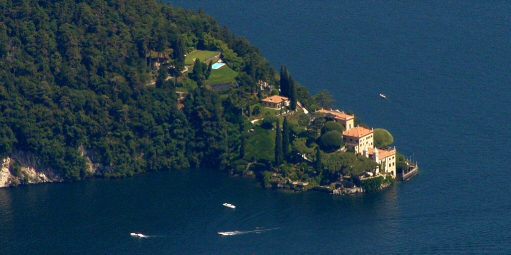 When observing the natural landscape in which this wonderful villa is immersed, it is easy to understand why Angelo Maria Durini chose to retreat to such a fabulous place. Balbianello, an admirable example of the perfect blend between architecture and nature, is situated at the far end of the Lavedo peninsula that extends into Lake Como. Cardinal Durini acquired the promontory in 1787. He erected a sort of sanctuary on an area where once stood a small Franciscan convent, with the intention to create a peaceful hideaway devoted to contemplative meditation of arts, which can be summarized in one word: Arcadia. The library, the music salon, the lodge overlooking the Tremezzina, on one side, and the Comacina Island, on the other, renamed respectively gulf of Venus and gulf of Diana…
When observing the natural landscape in which this wonderful villa is immersed, it is easy to understand why Angelo Maria Durini chose to retreat to such a fabulous place. Balbianello, an admirable example of the perfect blend between architecture and nature, is situated at the far end of the Lavedo peninsula that extends into Lake Como. Cardinal Durini acquired the promontory in 1787. He erected a sort of sanctuary on an area where once stood a small Franciscan convent, with the intention to create a peaceful hideaway devoted to contemplative meditation of arts, which can be summarized in one word: Arcadia. The library, the music salon, the lodge overlooking the Tremezzina, on one side, and the Comacina Island, on the other, renamed respectively gulf of Venus and gulf of Diana…A fairy-tale setting that became a place of rendezvous for representatives of the intellectual society of the time, from Giuseppe Parini to Silvio Pellico, from Berchet to Manzoni. In 1919 the villa passed to the Ames family from America and acquired years later (in 1974) by count Monzino, an explorer, who furnished it with memorabilia from his great past exploits (renowned in particular for his expedition to the North Pole and for being the first Italian ever to climb Mount Everest). Several beautiful Flemish tapestries are also worth mentioning as well as the valuable eighteenth-century English furniture. Today it is owned by FAI (Italian Fund for the Environment) and is often used as a movie location: Star Wars, Casino Royale and other movies.